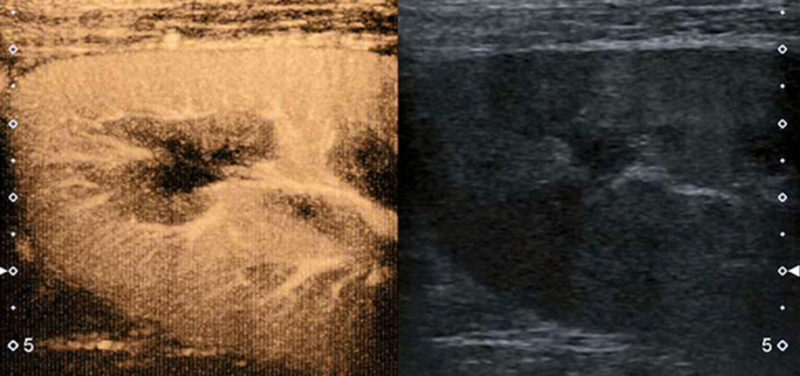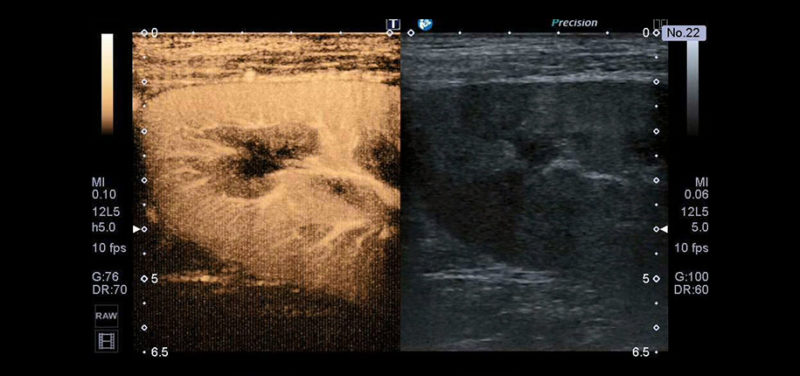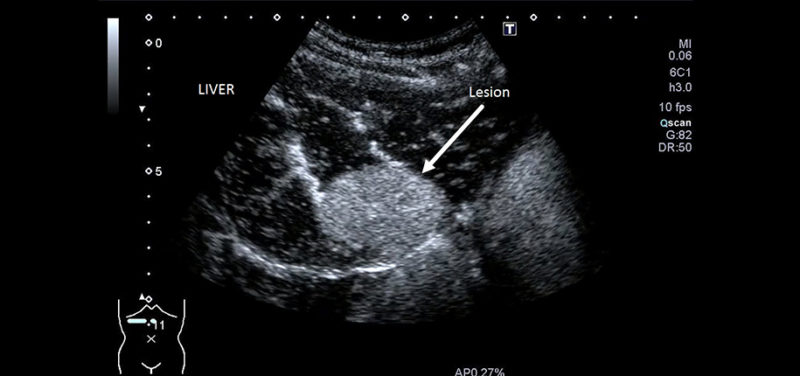
The Ultrasound Division at Cincinnati Children’s Radiology will soon be starting a new procedure involving bubbles! This procedure involves the use of contrast, which will help characterize non-specific lesions, assess blood flow to tissues and organs, and demonstrate vesicoureteral reflux. But this contrast is very different from the others used in radiology.
 Image: This image demonstrates the blood flow to the upper pole of a kidney. The image on the right is the usual gray-scale ultrasound image of the kidney, whereas the image on the left is contrast-enhanced, showing the vessels and the perfusion of the renal tissue.
Image: This image demonstrates the blood flow to the upper pole of a kidney. The image on the right is the usual gray-scale ultrasound image of the kidney, whereas the image on the left is contrast-enhanced, showing the vessels and the perfusion of the renal tissue.
Ultrasound contrast is composed of tiny gas-filled microspheres or bubbles that reflect the sonographic sound waves. These bubbles are smaller in size than a red blood cell, and easily travel through the bloodstream. They last approximately five minutes in the body before they burst. The bubble’s outer shell, made up of a lipoprotein, is filtered from the blood by the liver, where it gets broken down and eliminated. The gas portion of the bubble is filtered and eliminated by the lungs. This five-minute lifespan allows for multiple contrast injections if necessary.
The contrast, Lumason, was approved by the FDA for pediatric use in 2016, and has been marketed for over 14 years in more than 40 countries throughout the world. Contrast enhanced ultrasound is an outstanding imaging option due to its lack of radiation, portability, and cost. The use of bubbles provides no threat of kidney or liver toxicity, so it is safe to use in patients with impaired liver or kidney function.
 Image: This image shows a lesion within the liver, enhanced with ultrasound contrast. A lot of critical information regarding the lesion’s potential for malignancy can be garnered by observing the pattern and time of contrast “wash in” as well as the “wash out.”
Image: This image shows a lesion within the liver, enhanced with ultrasound contrast. A lot of critical information regarding the lesion’s potential for malignancy can be garnered by observing the pattern and time of contrast “wash in” as well as the “wash out.”
Special contrast-specific software on our ultrasound machines will enable us to obtain superb images of these tiny bubbles moving throughout the body, aiding in our diagnostic abilities. Short three-minute movies, or cine clips, as well as still images can be saved and later reviewed by the radiologist.
The time it takes for the contrast to “wash in” or “wash out” of a lesion, as well as the pattern of wash in/out, provides critical information to differentiate benign from malignant tissue. The sensitivity and specificity of contrast-enhanced ultrasound in differentiating suspicious lesions and tissues is outstanding, rivaling that of contrast enhanced CT or MR exams.
Additional applications of contrast enhanced ultrasound are on the horizon, giving us more options in our arsenal of imaging techniques to provide the best care for our patients.
Images contributed by Toshiba America Medical Systems.